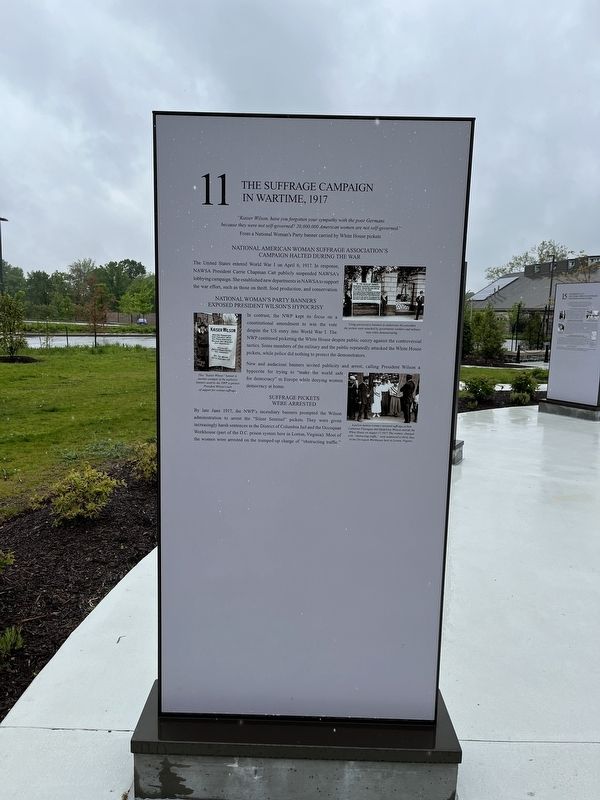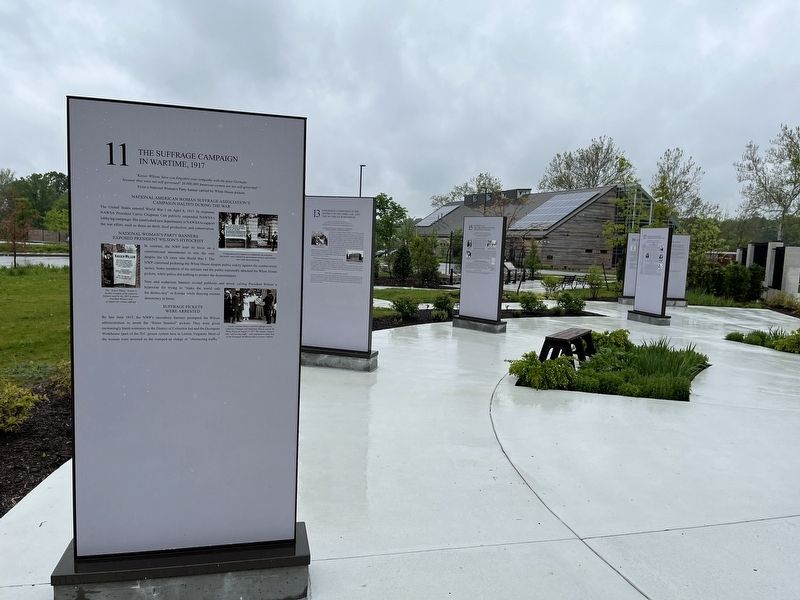Lorton in Fairfax County, Virginia — The American South (Mid-Atlantic)
The Suffrage Campaign in Wartime / Suffrage Pickets Chose Prison

Photographed By Devry Becker Jones (CC0), May 6, 2022
1. The Suffrage Campaign in Wartime side of the marker
The Suffrage Campaign in Wartime, 1917
"Kaiser Wilson, have you forgotten your sympathy with the poor Germany because they were not self-governed? 20,000,000 American women are not self-governed."
From a National Woman's Party banner carried by White House pickets
National American Woman Suffrage Association's Campaign Halted During the War
The United States entered World War I on April 6, 1917. In response NAWSA President Carrie Chapman Catt publicly suspended NAWSA's lobbying campaign. She established new departments in NAWSA to support the war effort, such as those on thrift, food production, and conservation.
National Woman's Party Banners Exposed President Wilson's Hypocrisy
In contrast, the NWP kept its focus on a constitutional amendment to win the vote despite the US entry into World War I. The NWP continued picketing the White House despite public outcry against the controversial tactics. Some members of the military and the public repeatedly attacked the White House pickets, while police did nothing to protect the demonstrators.
New and audacious banners invited publicity and arrest, calling President Wilson a hypocrite for trying to "make the world safe for democracy" in Europe while denying women democracy at home.
Suffrage Pickets Were Arrested
By late June 1917, the NWP's incendiary banners prompted the Wilson administration to arrest the "Silent Sentinel" pickets. They were given increasingly harsh sentences in the District of Columbia Jail and the Occoquan Workhouse (part of the D.C. prison system here in Lorton, Virginia). Most of the women were arrested on the trumped-up charge of "obstructing traffic."
[Captions:]
Using provocative banners to embarrass the president, the pickets were attacked by government workers and military men while demonstrating.
This "Kaiser Wilson" banner is another example of the explosive banners used by the NWP to protest President Wilson's lack of support for woman suffrage.
A police matron (center) arrested suffrage pickets Catherine Flanagan and Madeleine Watson outside the White House on August 17, 1917. The women, charged with "obstructing traffic," were sentenced to thirty days in the Occoquan Workhouse here in Lorton, Virginia.
Suffrage Pickets Chose Prison, 1917
"Your Honor, I have a nephew fighting for democracy in France. He is offering his life for his country, I should be proud of the honor to die in prison for the liberty of American women."
Mary Nolan, oldest imprisoned suffragist at the OccoquanWorkhouse, 1917Photographed By Devry Becker Jones (CC0), May 6, 20222. Suffrage Pickets Chose Prison side of the marker
Suffrage Pickets Sent to Prison at Occoquan Workhouse
As picketing and arrests continued, the court sentenced suffragists to longer terms of imprisonment at the District of Columbia Jail and the Occoquan Workhouse here in Lorton, Virginia. The sentences included the option of paying a fine, usually $25, which the women, with few exceptions, rejected. They said that to pay the fine would be an admission of guilt; they had committed no crime. Fearing the 73-year-old Mary Nolan (see quote above) would not survive, the judge tried to convince her to pay the fine. She refused.
Suffragists Experienced Deplorable Conditions in Prison
The Occoquan Workhouse kept suffragist prisoners in large dormitories rather than cell blocks. However, the warden placed the suffragists in the same room with African American prisoners, a highly unusual practice in that segregated time. As mostly middle and upper class white women unfamiliar with prison conditions, the suffragists found the food and sanitary conditions shocking. The food was bug-infested, and the bedding had not been laundered. They were prohibited from talking with each other or having outside contact, were not allowed writing materials, and were required to wear coarse, ill-fitting dresses and shoes. All personal items including toiletries were taken; their mail was

Photographed By Devry Becker Jones (CC0), May 6, 2022
3. The second half of the displays can be seen here.
[Captions:]
National Woman's Party suffragists as prisoners.
Suffragists and other female prisoners slept together in a large, dormitory-style room.
The building where the suffragists were imprisoned here in Lorton, Virginia, was torn down in the 1980s.
Erected 2021 by Turning Point Suffragist Memorial Association. (Marker Number 11/12.)
Topics and series. This historical marker is listed in these topic lists: Civil Rights • Communications • Government & Politics • Law Enforcement • War, World I • Women. In addition, it is included in the Former U.S. Presidents: #28 Woodrow Wilson series list. A significant historical date for this entry is April 6, 1917.
Location. 38° 40.935′ N, 77° 15.165′ W. Marker is in Lorton, Virginia, in Fairfax County. Marker is on Lorton Road, one mile south of Ox Road (Virginia Route 123), on the left when traveling east. Touch for map. Marker is at or near this postal address: 9751 Ox Rd, Lorton VA 22079, United States of America. Touch for directions.
Other nearby markers. At least 8 other markers are within walking distance of this marker. Worsening Conditions / Violent Repression (here, next to this marker); Victories in 1917 / Suffragists Demonstrated Until Congress Passed the 19th Amendment (a few steps from this marker); 1916 / Nonviolent Protests at the White House Gates (a few steps from this marker); Hard-Fought Ratification Campaigns in the States / The Continued Struggle for Voting Rights (a few steps from this marker); New Life in State by State Campaigns / The 1913 Suffrage Parade Captured National Attention (a few steps from this marker); Suffrage Campaigns State By State / New Leaders, New Approaches (a few steps from this marker); "Forward Out of Darkness" / Issuing a Call for Women's Rights (a few steps from this marker); "Forward Into Light," Toward Equality, 1920 - Present / The 19th Amendment (a few steps from this marker). Touch for a list and map of all markers in Lorton.
Credits. This page was last revised on May 7, 2022. It was originally submitted on May 7, 2022, by Devry Becker Jones of Washington, District of Columbia. This page has been viewed 172 times since then and 48 times this year. Photos: 1, 2, 3. submitted on May 7, 2022, by Devry Becker Jones of Washington, District of Columbia.
